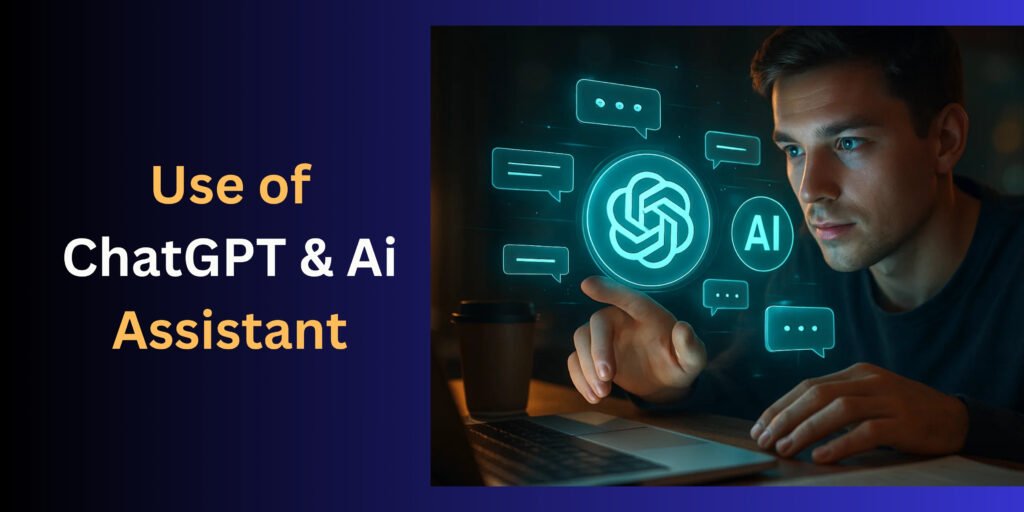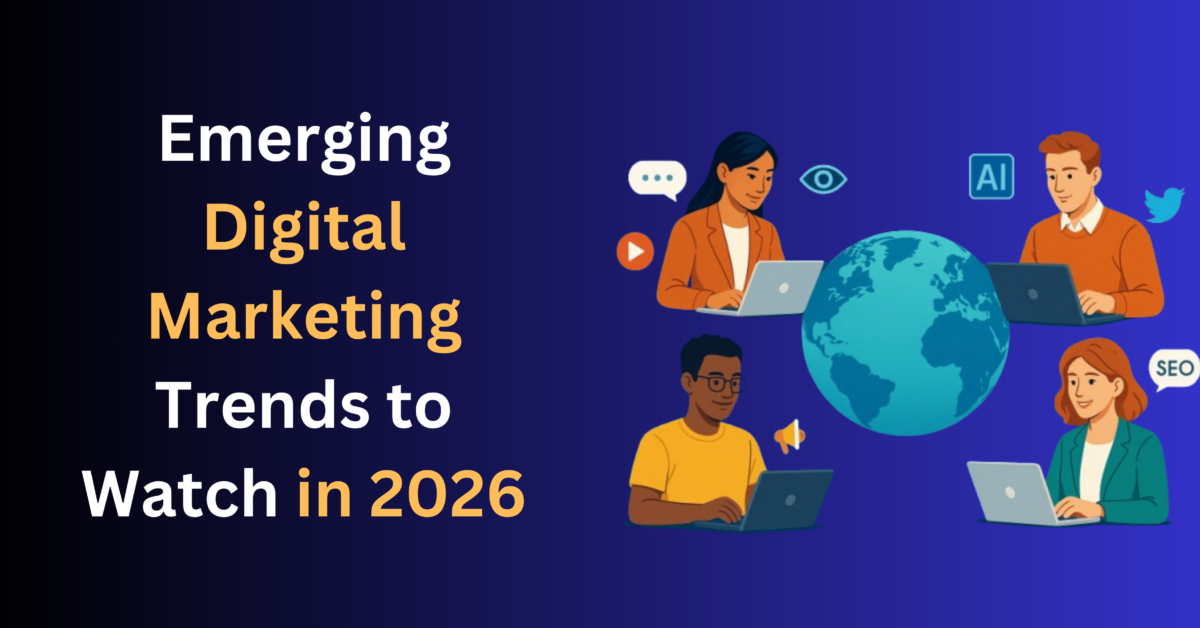Emerging digital marketing trends to watch in 2026
2026 will feel like the year marketing finally stops being just “digital” and becomes intelligently adaptive, privacy-aware, and multimodal. Expect generative AI agents to drive creative and optimisation, with short-form and AI-generated video dominating attention. First-party data and privacy-preserving attribution will replace old cookie tactics, and immersive/commerce experiences (AR/VR & social commerce) will become mainstream brand touchpoints. Below, unpack the biggest digital marketing trends, practical implications, metrics to track, and quick tactics you can apply this quarter.
1. Generative-AI and AI agents: creatives, campaign builders, and real-time optimisers
What’s changing:
Generative AI in marketing is no longer limited to static content drafts — 2026 digital marketing trends will see AI agents that autonomously build, test, and iterate campaigns across channels, including writing copy, creating variations of visuals/video, and adjusting budgets based on real-time performance signals. These agents will integrate with ad platforms, CRM, analytics and creative stacks to run many micro-experiments simultaneously.
Why it matters:
Brands who realy on social media advertising that combine human strategy with AI execution will iterate faster and spend ad dollars more efficiently.
How to act now:
- Pilot an AI-driven creative loop: feed top-performing assets into an AI tool that generates 10–20 variations and A/B test them automatically.
- Build guardrails: maintain brand tonebooks and an approval checkpoint to avoid hallucinations or off-brand outputs.
- Invest in tagging: ensure all creative variants are auto-tagged with metadata (audience, offer, version) to let the AI learn what works.
2. Answer-Engine Optimization (AEO) and “search” beyond Google

What’s changing:
Search is fragmenting. People get answers from generative AI assistants (ChatGPT, Gemini, others), in-app search experiences, and vertical answer engines. “SEO” now includes being discoverable inside AI responses and promptable knowledge graphs — sometimes called Answer-Engine Optimization (AEO)
Why it matters:
Traditional keyword ranking remains important, but you also need structured, concise content and schema markup that AI systems can ingest. Brands that optimize for “snippetable” answers, step-by-step guides, and structured FAQs will capture AI-driven organic discovery.
How to act now:
- Produce short, authoritative answers for high-intent queries and publish them in structured formats (FAQs, how-tos, data tables).
- Audit your content for “answerability”: can an AI extract a 1–3 sentence definitive answer plus a useful link?
- Add conversational prompts to pages (e.g., “Ask about pricing examples”) to help chat integrations.
3. Short-form and AI-generated video domination
What’s changing:
Short video formats (15–90 seconds) continue to win screen time and buying attention. Platforms are embedding AI video tools (creation, remixing, voiceovers), and some new apps are blending social and AI video generation features. Short video is both discovery and direct commerce driver.
Why it matters:
Attention is scarce—short, snackable formats with strong hooks convert better in many categories. AI tools lower production costs and enable dynamic personalization at scale (e.g., tailoring the first 3 seconds by audience segment).
How to act now:
- Rework your funnel: use short clips for TOF (brand + curiosity), slightly longer cutdowns for MOF (proof + demo), and CTA-heavy creatives for BOF (offers).
- Embrace remixability: create templates that the community and influencers can customize.
- Test AI-assisted video: generate UGC-style hooks and then iterate with human polish.
4. Privacy, first-party data, and the durable measurement stack
What’s changing:
Regulatory pressure and platform changes have reduced the reliability of third-party cookies. Even though Google’s timeline has shifted several times, the overall trajectory demands first-party data strategies and privacy-preserving measurement (Consent modes, Privacy Sandbox, server-side tracking).
Why it matters:
Attribution and audience targeting are getting re-architected. Marketers must own customer relationships (email, phone, authenticated app sessions) and use modeled attribution and clean rooms to measure performance.
How to act now:
- Build first-party capture flows: gated content, progressive profiling, loyalty programs, and app logins.
- Implement a measurement stack: server-side tagging, conversion modeling, and multi-touch modeling that respects consent.
- Use privacy-first identity solutions (hashed emails, hashed phone numbers) and explore cohort-based targeting when available.
5. AI-driven personalization without the “creep” factor
What’s changing:
Consumers like personalization, but they reject invasive signals or surprises. The winning strategy is transparent personalization that explains value (better recommendations, time saved) in exchange for permissioned data. Brands will combine real-time session signals, first-party profiles, and generative AI to create micro-personalized experiences.
Why it matters:
Personalization that feels helpful improves conversion and loyalty; personalization that feels creepy damages trust.
How to act now:
- Offer clear value for data: e.g., “Share your size/likes for 10% off + faster recommendations.”
- Surface why a recommendation is shown (e.g., “Recommended because you liked X”).
- Use on-device or ephemeral signals where possible to keep sensitive data local.
6. Programmatic + real-time creative optimization
What’s changing:
Programmatic buying becomes more creative-aware. Ads will be dynamically assembled at scale — mixing headline, visual, CTA, and offer based on audience signals. AI optimizes not only bidding but the creative mix.
Why it matters:
Shifts ad spend toward platforms and partners that support dynamic creative and feed-based personalization; static image sets will underperform.
How to act now:
- Use dynamic creative optimization (DCO) for ad sets serving multiple cohorts.
- Maintain a creative asset library with modular components and metadata.
- Monitor creative decay and automate refresh cycles.
7. Commerce + social commerce convergence
What’s changing:
Social platforms keep integrating buying experiences — livestream shopping, in-app checkout, shoppable short video. Commerce is becoming conversational and social-first, shortening the path from discovery to purchase.
Why it matters:
Brands that integrate shopping into content reduce friction and boost conversion rates from organic reach and influencer campaigns.
How to act now:
- Test live selling events and shoppable posts with limited offers.
- Sync product catalog to social platforms and enable fast checkout.
- Create a content plan that blends entertainment and commerce (educational entertaining demos).
8. Voice, multimodal search, and on-device assistants
What’s changing:
Voice search optimization and multimodal assistants (text + image + voice) gain traction — especially in mobile and connected home devices. Marketers should optimize for conversational queries and multimodal result formats (images, video clips, and quick lists).
Why it matters:
Queries are longer and more conversational; brands that can answer the “why” and “how” succinctly will appear in assistant results.
How to act now:
- Add conversational FAQs and audio transcripts to pages.
- Optimize product content for long-tail, question-style queries.
- Consider branded actions/skills for major assistants if relevant.
9. Immersive experiences: AR, lightweight XR, and brand worlds
What’s changing:
Augmented reality (try-on, visualizers) has matured; XR/virtual experiences will be used more for product trials, events, and deeper storytelling. These aren’t just gimmicks — they reduce returns and increase confidence for high-consideration purchases.
Why it matters:
Experience sells. For categories like fashion, furniture, cosmetics and autos, AR experiences materially improve conversion and lower returns.
How to act now:
- Start with lightweight AR: 3D product viewers and try-on in social apps.
- Build showrooms or virtual events for product launches.
- Measure downstream impact: return rate, time to purchase.
10. Creator economy evolution: long-term partnerships & creator-led brands
What’s changing:
Platforms favor creators; savvy brands are shifting from one-off influencer pushes to deeper, co-created IP (product lines, co-branded stores, affiliate programs). Creator trust beats celebrity reach in many niches.
Why it matters:
Creators provide both content scale and built-in audiences. Long-term deals and revenue sharing produce authentic content and higher ROAS.
How to act now:
- Build long-term creator cohorts, not spot buys.
- Give creators creative control and revenue upside (affiliate links, product collabs).
- Use creators for product discovery and community building — not just performance ads.
Measurement, org structure & tech-stack implications
- Measurement: Rely more on uplift tests, holdout groups, and modeled attribution. Invest in clean rooms or partner with platform-level privacy tools.
- Org: Hire “AI prompt engineers / ops” inside marketing or train existing teams to design experiments, validate outputs, and manage ethical/risk checks.
- Tech stack: Expect to combine AI creative tools, a CDP for first-party profiles, server-side tagging, and a composable stack (modular martech) for faster integration.
Risks & ethical considerations
- Hallucinations and brand risk: AI can create plausible but incorrect claims. Always human-verify product claims and legal copy.
- Privacy backlash: Over-personalization without consent will harm trust. Be transparent and give users control.
- Platform dependency: Heavy reliance on a single social platform or AI provider risks business continuity. Diversify channels and own customer data.
Measurement cheat-sheet (what to track now)
- First-party match rate (% signed in users)
- Creative time-to-win (days until new creative reaches statistical significance)
- View-to-conversion (for short video)
- Holdout uplift (true lift vs modeled)
- AR conversion lift & return reduction
Final recommendations (practical priorities)
- Own customer relationships. Build a CDP and capture first-party signals today.
- Adopt AI with human oversight. Use AI to multiply creative output but keep humans in the review loop.
- Treat short video as a core channel. Optimize content for hooks and remixes.
- Design for privacy by default. Transparent value exchanges for data = sustainable targeting.
- Experiment constantly. Use small holdout groups to validate new AI-driven tactics before full rollout.
Conclusion
2026 digital marketing trends won’t be about single “silver-bullet” tactics. It will reward companies that combine three capabilities: sophisticated AI execution (with guardrails), ownership of first-party data and consented identity, and nimble creative systems that win attention in short-form and multimodal channels. Start small, measure rigorously, and scale what actually lifts revenue.
Metaloop Marketing — known for performance-driven digital strategist and top-notch digital marketing agency in Surat — is a great digital marketing trends example to study for combining technical tracking, creative testing, and SEO/paid synergies when you plan execution



Write a Comment